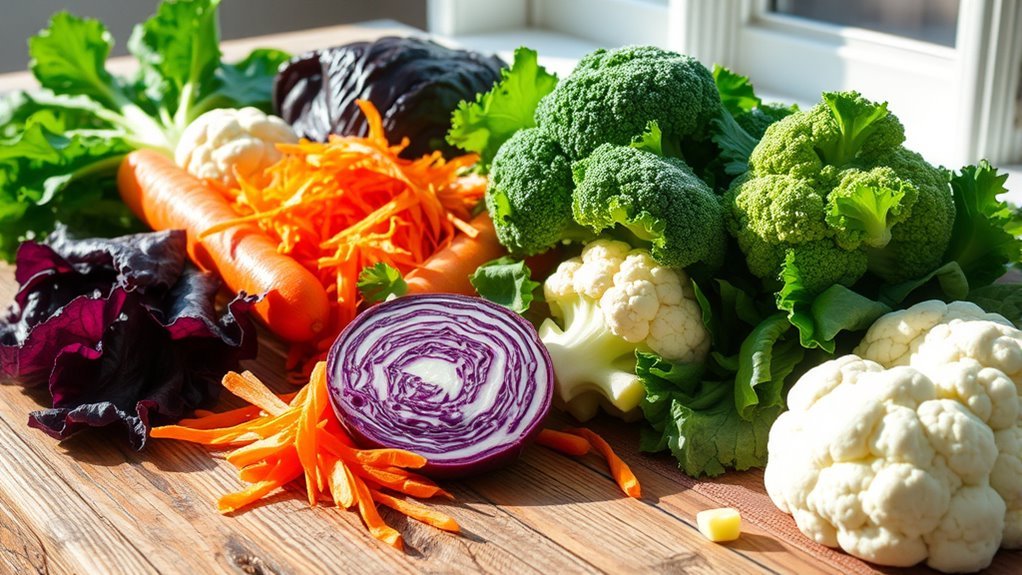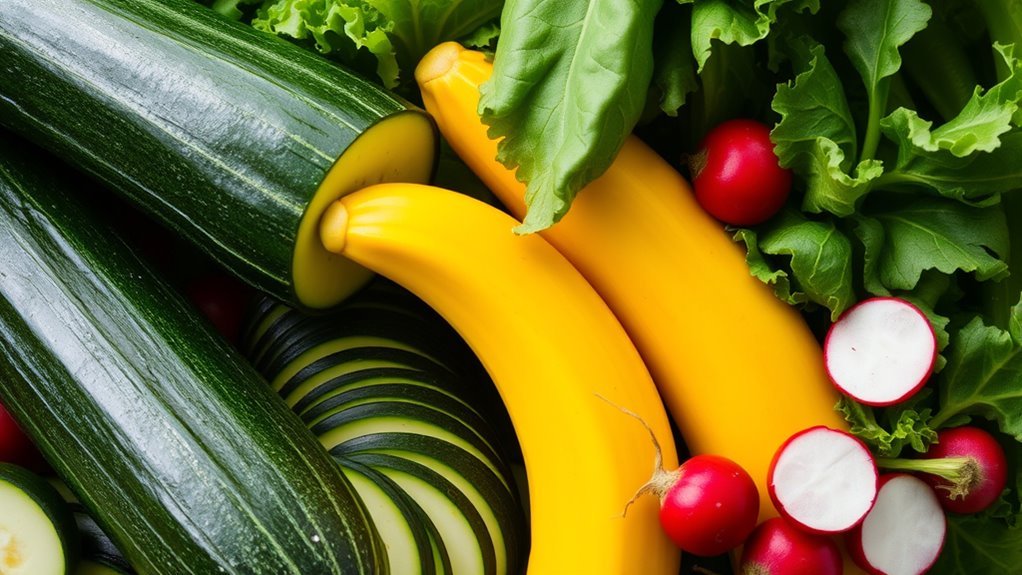On a keto diet, you can enjoy a variety of low-carb vegetables. Leafy greens like kale and spinach are packed with nutrients. Cruciferous veggies such as broccoli and cauliflower are high in vitamins and fiber. Zucchini, bell peppers, mushrooms, and avocados are great choices too. Cucumbers and asparagus provide hydration and essential nutrients, while radishes add crunch and flavor. Each of these options supports your keto goals, and there’s a lot more to discover about how they fit your meals.
Leafy Greens

When you’re on a keto diet, incorporating leafy greens is essential for maintaining your nutrient intake while keeping carbs low. Leafy greens like kale and spinach are particularly beneficial, offering a wealth of vitamins and minerals. Kale benefits include high levels of antioxidants and vitamin K, which support overall health. Plus, it’s versatile enough to be eaten raw, sautéed, or blended into smoothies. On the other hand, spinach varieties such as baby spinach and savoy spinach provide unique textures and flavors, making them ideal for salads or cooking. Both options are low in carbs and high in fiber, helping you feel full longer. By including these greens, you can enjoy a satisfying keto diet while nourishing your body.
Cruciferous Vegetables

Cruciferous vegetables, like broccoli and cauliflower, are packed with essential nutrients and low in carbs, making them perfect for your keto diet. These veggies offer a wealth of health benefits, including antioxidants and fiber, which can support digestion and overall well-being. You might want to contemplate incorporating popular choices into your meals for a nutritious boost.
Nutritional Benefits Explained
Although you may think of vegetables as merely a side dish, cruciferous vegetables offer a wealth of nutritional benefits that can greatly enhance your health, especially on a keto diet. Packed with keto-friendly fiber, these veggies help maintain digestive health while keeping your carb count low. They’re rich in low-carb nutrients like vitamins C, E, and K, along with crucial minerals such as calcium and potassium. This nutrient density supports various bodily functions, including immune health and bone strength. Additionally, cruciferous vegetables contain antioxidants that combat inflammation, promoting overall well-being. Incorporating these powerhouses into your meals not only aligns with keto guidelines but also guarantees you’re fueling your body with crucial nutrients for peak performance and well-being.
Popular Choices to Consider
Here are five popular cruciferous vegetables you should consider incorporating into your keto diet. These veggies not only provide essential nutrients but also offer impressive keto vegetable benefits thanks to their low carb options.
| Vegetable | Keto Benefits |
|---|---|
| Broccoli | High in fiber, low in carbs |
| Cauliflower | Versatile alternative to grains |
| Brussels Sprouts | Rich in vitamins C and K |
| Kale | Packed with antioxidants |
Adding these cruciferous vegetables to your meals can enhance nutrient intake while keeping your carb count low. They’re perfect for salads, stir-fries, or as side dishes. Embracing these options allows you to enjoy a diverse, satisfying diet while staying aligned with your keto goals.
Zucchini and Squash

Zucchini and squash are excellent additions to your keto diet, offering low-carb options packed with vitamins and minerals. You can enjoy them in various cooking methods, from grilling to sautéing, making them versatile staples. Plus, there are countless recipe ideas that can keep your meals exciting and nutritious.
Nutritional Benefits Overview
When you’re looking to incorporate low-carb vegetables into your keto diet, zucchini and squash stand out due to their impressive nutritional profiles. These keto vegetable varieties are low in calories yet rich in vitamins and minerals, making them excellent choices for your health. They offer dietary fiber benefits, which aid digestion and keep you feeling full longer.
| Nutrient | Zucchini | Squash |
|---|---|---|
| Calories | 17 kcal | 36 kcal |
| Fiber (g) | 1.1 | 2.2 |
| Vitamin C (mg) | 17 | 9 |
Incorporating zucchini and squash into your meals can provide essential nutrients while supporting your low-carb lifestyle. Enjoy the freedom of choosing healthy options!
Cooking Methods Explained
Cooking zucchini and squash can be both simple and versatile, allowing you to enjoy their flavors while sticking to your keto diet. One popular method is sautéing, where you cut the veggies into uniform pieces and cook them in a bit of olive oil. This technique enhances their natural sweetness and keeps them tender-crisp. Aim for medium heat to avoid overcooking.
Roasting is another excellent option; it brings out the rich flavors and creates a delightful texture. Preheat your oven, toss the veggies with olive oil, salt, and your favorite herbs, then roast until golden. Both sautéing techniques and roasting methods are low-carb and maintain the integrity of these delicious veggies, making them perfect for your keto meals. Enjoy the freedom of experimenting!
Recipe Ideas Galore
Finding new ways to incorporate zucchini and squash into your meals can keep your keto diet exciting and flavorful. These versatile veggies can be used in numerous recipes, from zoodles to casseroles. Here are some quick ideas for keto meal prepping:
| Recipe Ideas | Description |
|---|---|
| Zucchini Noodles | Spiralize zucchini for a pasta substitute, topped with low-carb marinara. |
| Stuffed Squash | Fill halved squash with ground meat and cheese for a hearty dish. |
| Zucchini Chips | Thinly slice zucchini, season, and bake for a crunchy snack. |
| Ratatouille | Combine zucchini and squash with other low-carb veggies in a savory stew. |
| Dips | Blend zucchini for creamy low carb dips, perfect for snacking. |
Experiment with these ideas to keep your meals fresh and satisfying!
Bell Peppers
Although many people think of bell peppers as just a colorful addition to salads, they’re a fantastic choice for those on a keto diet. With various bell pepper varieties—like green, red, yellow, and orange—you can enjoy different flavors and textures while keeping your carb count low. Bell pepper nutrition is impressive, too; they’re low in calories and rich in vitamins A and C, which support your immune system. Plus, they provide antioxidants that promote overall health. Just one cup of sliced bell peppers contains around 6 grams of carbs, making them a perfect veggie for your keto meals. So, don’t hesitate to add bell peppers to your favorite dishes for a burst of flavor and nutrition!
Mushrooms
Mushrooms are another excellent choice for those following a keto diet. With several mushroom varieties, like cremini, shiitake, and portobello, you can add rich flavors to your meals without increasing your carb intake. These fungi are low in calories and carbohydrates, making them perfect for maintaining ketosis.
Beyond their versatility, mushrooms offer numerous health benefits. They’re packed with antioxidants, which can help combat oxidative stress, and they provide essential nutrients such as vitamin D and B vitamins. Plus, they’re a great source of fiber, supporting digestive health. Including mushrooms in your keto meals not only enhances taste but also contributes to your overall well-being, giving you the freedom to enjoy diverse and nutritious dishes.
Avocado
When you’re on a keto diet, incorporating avocados into your meals can be a game-changer. These delicious fruits are low in carbs and high in healthy fats, making them perfect for your weight loss goals. Plus, there are several avocado varieties, each offering unique flavors and textures to keep your meals exciting.
Consider these health benefits of avocados:
- Rich in monounsaturated fats, promoting heart health
- Packed with fiber, aiding digestion and keeping you full
- Loaded with potassium, helping to regulate blood pressure
- Contain antioxidants, supporting overall well-being
Cucumbers
Avocados are just one of the many vegetables you can enjoy on a keto diet, and cucumbers are another fantastic option. With their low carb content, cucumbers are perfect for keeping your macros in check. There are several cucumber varieties, including English, Persian, and pickling cucumbers, each offering a revitalizing crunch to salads or snacks.
Cucumbers are not just hydrating; they’re also packed with essential nutrients like vitamins K and C. Plus, their high water content helps you stay hydrated, which is vital on a keto diet. Whether you slice them up for a salad or enjoy them as a crunchy snack, cucumbers can enhance your meals without compromising your diet goals. So go ahead, enjoy the crisp benefits!
Asparagus
Asparagus, a nutrient-dense vegetable, is an excellent addition to your keto diet. This versatile veggie is low in carbs and packed with vitamins, making it a powerhouse for health-conscious eaters. You can enjoy various asparagus varieties, such as green, purple, and white, each offering unique flavors and textures.
Here are some delicious asparagus recipes to try:
- Grilled Asparagus: Drizzle with olive oil and season with salt for a smoky taste.
- Asparagus Soup: Blend cooked asparagus with broth for a creamy delight.
- Roasted Asparagus: Toss with parmesan and bake for a savory side dish.
- Asparagus Salad: Mix with cherry tomatoes and a lemon vinaigrette for a revitalizing meal.
Incorporating asparagus into your meals can keep your keto journey exciting and nutritious!
Radishes
Radishes are a crunchy and flavorful addition to your keto diet, offering a low-carb option that can enhance various dishes. With only about 1 gram of net carbs per half-cup serving, they’re perfect for maintaining ketosis. Radish benefits include being rich in antioxidants and vitamin C, supporting your immune system and overall health.
You can enjoy cooking radishes in several ways—roasting can mellow their peppery flavor, while sautéing brings out their natural sweetness. You might even slice them raw for salads or as a crunchy snack. Incorporating radishes into your meals not only adds variety but also helps fulfill your nutritional needs without sacrificing your keto goals. Experiment with different cooking methods to discover what you enjoy most!


